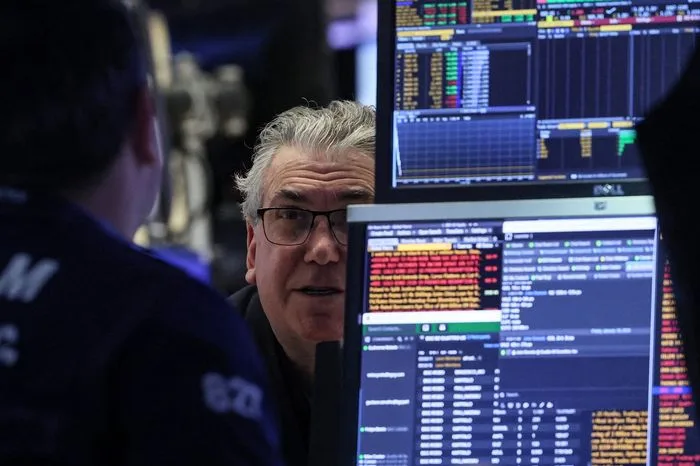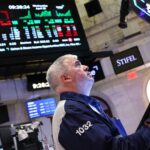By Andrew Moran
With the Federal Reserve signaling upcoming interest rate cuts and both the White House and private sector ramping up investment in strategic areas, concerns over a potential asset bubble are gaining traction among economists and market analysts.
Wall Street has shrugged off numerous headwinds since the trade-driven selloff in April. U.S. stocks continue to register fresh all-time highs amid higher tariffs, cooling employment conditions, sticky inflation, and volatile geopolitics.
Fueled by strong corporate earnings and heightened optimism surrounding artificial intelligence, the broader S&P 500 and the tech-heavy Nasdaq Composite Index have risen more than 10 percent and 12 percent year to date, respectively. The blue-chip Dow Jones Industrial Average has climbed about 8 percent.
This is happening as the Federal Reserve has kept interest rates higher for a more extended period.
After reducing the benchmark federal funds rate—an influential policy rate that impacts borrowing costs for businesses, consumers, and governments—by 1 percent from September to December 2024, the central bank hit the pause button. Since January, monetary policymakers have maintained the target rate within a range of 4.25 to 4.5 percent as they await further clarity from the current administration’s trade policy changes.
The idea presented by Fed Chair Jerome Powell and many of his colleagues is that they can afford to be patient, as economic activity remains robust and labor market conditions stay healthy.
Powell might have pivoted.
Interest Rate Cuts Coming
In his final keynote address at the central bank’s annual Jackson Hole retreat, Powell stated that current economic conditions “may warrant” a policy change.
Investors analyzed this comment as a hint of a quarter-point rate reduction, with traders overwhelmingly pointing to September. Markets are also pricing in two more 25-basis-point rate cuts by the year’s end, according to the CME FedWatch Tool.
The U.S. economy could be at the beginning of a more aggressive easing cycle, especially if President Donald Trump can continue to overhaul the makeup of the U.S. central bank.
The White House selected Council of Economic Advisers head Stephen Miran as resigning Fed board member Adriana Kugler’s temporary replacement. With the president also terminating Fed board member Lisa Cook this week on mortgage fraud allegations, the administration could temporarily appoint another ally to her seat.
With two dovish officials sitting at the rate-setting Federal Open Market Committee—Fed board member Christopher Waller and Fed Vice Chair for Supervision Michelle Bowman—the institution’s monetary policy stance could shift heading into the new year.
Treasury Secretary Scott Bessent has conveyed that the federal funds rate should be much lower.
“I think we could go into a series of rate cuts here, starting with a 50 basis-point rate cut in September,” Bessent said in an Aug. 13 interview with Bloomberg Television. “If you look at any model … we should probably be 150, 175 basis points lower.”
Officials believe that lower rates would bolster the weakening U.S. labor market, stimulate economic growth prospects, and reduce the federal government’s debt-servicing payments. In pursuit of better yields, a low-rate environment would also enable investors to diversify into other assets, including stocks, real estate, cryptocurrency, and artificial intelligence.
A massive transition would also inflate valuations across various asset classes at a time when market watchers are sounding alarm bells about the formation—or potential ballooning—of bubbles, especially in artificial intelligence and the broader technology industry.
Blowing Bubbles
Torsten Slok, chief economist at Apollo Wealth Management, has presented striking similarities between today’s market and the dot-com bubble of the late 1990s and early 2000s, also called the “IT” or Information Technology bubble.
About 30 years ago, a tech-driven euphoria swept Wall Street, with investors pouring capital into tech startups, particularly companies with “.com” in their names. Pets.com and eToys.com were among the most popular businesses among traders and venture capitalists at the time. From January 1995 to March 2000, the Nasdaq surged from around 750 points to 5,000.
Today, Wall Street is enamored of the so-called Magnificent Seven: Alphabet, Amazon, Apple, Meta, Microsoft, Nvidia, and Tesla. These companies account for about half of the Nasdaq’s total market capitalization and approximately a third of the S&P 500’s total market cap.
“The difference between the IT bubble in the 1990s and the AI bubble today is that the top 10 companies in the S&P 500 today are more overvalued than they were in the 1990s,” Slok said in a July note emailed to The Epoch Times.

“The situation today is surprisingly similar to the IT bubble in the 1990s,” he said.
Another metric to monitor a possible bubble, said Tom Essaye, the president and co-founder of the Sevens Research Report, is the Semiconductor Index, or SOX. This is a benchmark that tracks the performance of major companies in the semiconductor industry, such as Advanced Micro Devices, Nvidia, and Broadcom.
SOX, Essaye said, “is not flashing an optimistic signal for the potential sustainability of the current bull market.”
At the same time, SOX is hovering below last summer’s record highs and is trailing the S&P 500.
“If there is an AI bubble, then cycle risks are as elevated as they have been in nearly two decades; and if that is the case, then a greater sense of caution is warranted regarding equity exposure in H2’25,” Essaye said in a note emailed to The Epoch Times.
Ultimately, according to Essaye, it is crucial to determine the stage of the economic cycle in which the stock market is currently operating. “Historically speaking, almost every major market bubble has been ‘inflated’ in a late-stage environment of the economic cycle,” he added.
Others are skeptical that this is either a bubble or a bubble on the verge of popping.
Joe Tigay, portfolio manager at Equity Armor Investments, says S&P 500 businesses are bolstering their capital expenditures on AI infrastructure, “showing this is a long-term investment trend, not a temporary fad.”
“This is not a classic bubble on the verge of popping,” Tigay said in a note emailed to The Epoch Times. “This isn’t just a handful of tech giants; it’s a broad, fundamental shift in how corporations operate.
“Yes, it might be a bubble,” he continued, “but in my view, it’s a bubble that’s nowhere near bursting.”
Based on recent quarterly earnings calls, businesses have been pleased with their AI investments as worker productivity has increased, said Nancy Tengler, CEO at Laffer Tengler Investments. Profit margins are also holding steady, even in the face of the president’s higher tariff rates.
“We believe we are just getting started on this AI ride,” Tengler said in a note emailed to The Epoch Times.
According to a February 2024 paper published in the National Bureau of Economic Research, only 5.4 percent of businesses have adopted generative AI.
But the early numbers are signaling an increase in productivity levels.
This past winter, a paper by economists at the St. Louis Federal Reserve highlighted that workers, on average, are 33 percent more productive in each hour they use generative AI. But they say these productivity gains may not be reflected in the hard data for some time.
“We emphasize that these potential productivity gains from generative AI may not immediately appear in productivity statistics, at least for now,” the paper stated.
Sovereign Wealth Fund
It is not only the New York Stock Exchange that is hyper-focused on AI and tech.
The president has attracted trillions of dollars in private capital investment—at home and abroad—to build America’s AI infrastructure, from data centers to factories, in the coming years.
But the White House might not be done.
Last week, Trump confirmed the U.S. government is taking a 10 percent ownership stake in chipmaker Intel. The president and senior administration officials have suggested that similar arrangements could be made in the future, with National Economic Council Director Kevin Hassett pointing to Trump’s executive order earlier this year, which established a sovereign wealth fund.
“The president has made it clear all the way back to the campaign that he thinks that in the end, it would be great if the U.S. could start to build up a sovereign wealth fund,” Hassett said in an Aug. 25 interview with CNBC’s “Squawk Box.” “So I’m sure that, at some point, there’ll be more transactions—if not in this industry, in other industries.”
Taking to social media, Trump stated that he would execute deals like Intel “all day long.”
“Yeah, there will be other cases, or if I have that opportunity again, I would do that. Then you do have stupid people say, ‘Oh that’s a shame,’” Trump said in an Aug. 25 Truth Social post. “It’s not a shame. It’s called business.”
A combination of private and public investments into AI and the broader tech market could further add to already elevated valuations.
Cheaper Capital on the Horizon
Ultimately, lower interest rates reduce borrowing costs, resulting in lower capital costs. This creates a dual scenario in a bullish climate.
First, it is easier for companies to raise money, allowing businesses to access cheap capital to fund projects. Second, investors seeking higher yields are more likely to fund these projects as they pursue growth.
Additionally, lower interest rates reduce the discount rate used in valuation models—a measure of future cash flows in today’s dollars—which inflates the present value of future earnings. Because AI businesses promise long-term returns, their valuations rise disproportionately when rates fall.
At the same time, Tigay says, companies are “putting real money into a real technology.”
“The only thing that can kill this growth story is a full-blown economic recession that forces companies to stop spending,” he said.
In the second quarter, the U.S. economy expanded 3.3 percent, better than initially reported. Looking ahead to the third quarter, the Atlanta Fed’s GDPNow Model suggests 2.2 percent growth.





